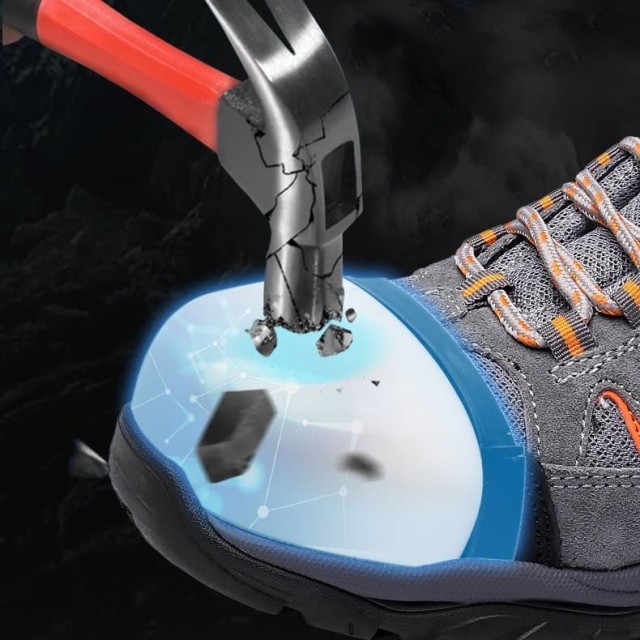When selecting safety footwear, the choice between composite and steel toe caps isn't just about cost—it's about matching material properties to your work environment. Composite materials offer unique advantages in electrical hazard zones, cold climates, and high-mobility jobs, while steel remains the budget-friendly choice for heavy industrial settings. Let's analyze when composite toes justify their premium.
Safety Standards and Material Properties
All safety toe caps—whether steel, aluminum, or composite—must meet ASTM F2413 impact and compression resistance standards (200 J impact/15 kN compression for boots). However, their material differences create distinct workplace advantages:
Composite Toe Benefits:
- Non-Conductive: Essential for electricians and utility workers (protects against 600V circuits)
- Temperature Neutral: Won't transfer extreme heat/cold like metal
- Lightweight: Up to 30% lighter than steel, reducing fatigue
- Metal Detector Safe: Critical for airports, secure facilities
Steel Toe Advantages:
- Lower Upfront Cost: Typically 15-20% cheaper initially
- Higher Density: Thinner profile for the same protection level
- Proven Durability: Performs consistently in high-abrasion environments
"Have you considered how daily exposure to electrical hazards or cold temperatures could make composite toes a long-term cost saver?"
Workplace Scenarios Demanding Composite’s Advantages
1. Electrical Hazard Environments
EH-rated composite toes (made from Kevlar/fiberglass) are mandatory for:
- Electricians working on live circuits
- Telecom technicians near power lines
- Manufacturing plants with exposed wiring
Steel toes pose electrocution risks in these settings despite meeting ASTM standards for impact protection.
2. Extreme Temperature Work
Composite outperforms steel in:
- Cold Storage (-40°F/-40°C): Prevents conductive heat loss
- Foundries/Steel Mills: Doesn’t heat up like metal
3. High-Mobility Roles
The weight savings benefit:
- Warehouse pickers walking 8+ miles daily
- Construction crews on scaffolding
- Emergency responders needing rapid movement
Cost vs. Long-Term Value Breakdown
| Factor | Steel Toe | Composite Toe |
|---|---|---|
| Initial Cost | $80-$120 | $100-$160 |
| Replacement Cycle | 12-18 months | 18-24 months |
| Fatigue Reduction | Minimal | Significant |
| Specialized Use Cost | Requires EH add-ons | Built-in EH protection |
Example: A wind turbine technician working at height benefits from composite’s lightweight design—reducing leg fatigue could prevent $5,000+ in annual productivity losses from slower movement.
Industry-Specific Recommendations
Construction (General)
- Steel Toe: Cost-effective for ground crews handling heavy materials
- Composite: Ideal for roofers/elevated work where weight matters
Oil & Gas
- Composite: Non-sparking properties prevent ignition in flammable areas
Aerospace/Automotive
- Composite: Passes through security checkpoints without delays
Food Processing
- Composite: Resists corrosive washdown chemicals better than steel
Upgrade Your Safety Footwear Strategy with 3515
As a full-service manufacturer for distributors and brands, 3515 delivers ASTM-compliant composite and steel toe footwear engineered for your clients' specific hazards. Our materials science expertise ensures optimal protection-to-weight ratios—whether you need EH-rated solutions for utilities or lightweight designs for logistics teams. Let’s collaborate to build safety footwear that balances cost and performance.
Related Products
- Customizable Anti-Smash Safety Boots for Wholesale & Private Label Manufacturing
- Athletic Safety Shoes with Dial Closure & Steel Toe for Wholesale & Custom Manufacturing
- Wholesale Customizable Safety Boots Durable & Protective Footwear Manufacturing
- Wholesale Mesh Steel Toe Safety Shoes with Dial Closure Factory Production
- Wholesale Durable Breathable Safety Boots Custom OEM Manufacturer
Related Articles
- How Steel Toe Shoes Prevent Injuries: The Science Behind Workplace Safety
- How to Reduce Foot Injury Risks in High-Risk Workplaces: 3 Proven Strategies
- Steel-Toe vs. Composite-Toe Boots: How to Choose the Right Safety Footwear for Your Job
- How Steel Toe Shoes Meet Safety Standards and Prevent Workplace Injuries
- Steel Toe Work Boots: Balancing Safety and Comfort for Demanding Jobs




















